Foraging is a vital part of any food security survival plan. If you know what to look for, food can be found in all four seasons – even in an urban environment.
But, if you look, touch, or taste the wrong plants, what you pluck from the woods and pop into your mouth may just might be your last meal.
One of the most dangerous types of poisonous plants a forager can come across are look-a likes, or doppelgangers of popular and medicinal plants. A newbier forager, a careless forager, or a desperate person in a survival situation.
Learn what poisonous plants grow in your area, and not only commit them to memory but you should also be able to quickly and easily differentiate between them and edible wild look-a-likes.
Whatever plants you choose to forage, you always have to be very, very careful, and 100% sure before you use or consume them in any way.
Disclaimer: the advice given in this article is provided “as-is”, and is for information purposes only. neither the website nor the author hold any responsibility for any side effects as a result of the advice given in this article. Use extreme caution when identifying plants.
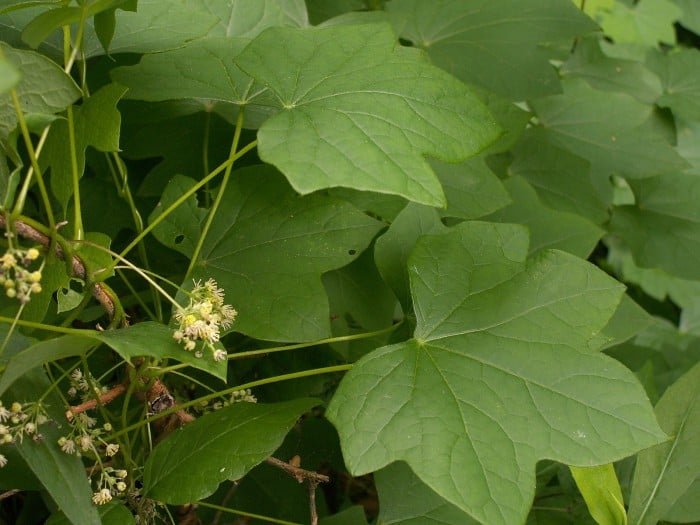
Table of Contents
❌ 1. Canadian Moonseed – Fox Grapes (menispermum canadense)
Fox grapes can easily be mistaken for wild grapes in the woods. The grapevine genus (Vitis) encompasses 60 different species that all have berries, leaves, vines, and sometimes even trunks and roots that look similar.
Nearly all of the 60 grapevine species grow throughout North America. There are three main varieties that commonly grow that are safe to eat for most people: V. labrusca, V. rupestris, and V. aestivalis.
But, canadian moonseed is a dead ringer for some wild grape varieties – pun intended.
The fruit produced by this poisonous plant looks eerily similar to both wild grapes and even to some grape bushes you can purchase at a garden supply store and cultivate.
It is not wholly uncommon for Fox Grapes to grow amid a patch of wild grapes, increasing the chances that a novice or less than diligent forager will toss some of them into their mouths along with the ones that are safe to eat.
Every single part of the Canadian Moonseed plant is toxic for all humans. The moonseed berries have just one crescent shape seed, which would seemingly make them different enough from rounded wild grape berries.
But, one would have to actually pause, and carefully inspect the shape of the berry that is similar in shape and color, and comes from a plant that also roughly resembles a wild grape plant, to be able to tell the difference.
Canadian Moonseed plants contain dauricine.
This chemical is labeled as a phenol – an aromatic ether as well as being known as an isoquinoline alkaloid. The dose of dauricine in a Fox Grape berry can be fatal.
Learning how to tell the difference between safe to eat wild grapes and Canadian Moonseed bushes should begin by an inspection of the vines.
The vines on the poisonous plant do not possess forked tendrils like grapevines. If you tasted a Fox Grape, you would immediately notice that it did not taste sweet or even the slightest bit yummy, but downright awful.
Some Native American tribes did use Fox Grapes in skin treatments and laxative remedies, so you might find a natural herbal recipe containing this plant on the web if you searched long and hard enough.
However, just to be on the safe side, just learn how to identify Canadian Moonseed and keep your sack far away from it when foraging.
❌ 2. False Morels (gyromitra esculenta)
Mushrooms are one of the most potentially dangerous items you could pick in the forest if you are not an experienced and conscious forager.
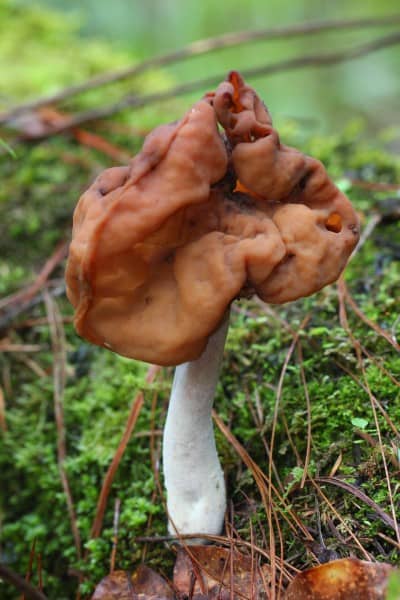
Not only are many varieties of mushrooms toxic to humans, there are deadly look-a likes to some of the popular safe to eat varieties, too.
On the other hand, real morel mushrooms are simply delicious. The hills in my region of Appalachia are swamped with foragers hunting Morels (Morchella genus) for two weeks every year when mushroom seasons “comes on.”
Finding a real morel in the woods during a survival situation can give you a tasty and nutrient rich meal, but failing to choose wisely could turn you into just another disaster statistic in rapid fashion.
How To Identify True Morels
True morels have a spongy look and texture, but “Hickory Chickens” are members of the Verpa genus, and do not boast this same texture – but can closely mimic the look of true Morels.
Gyromitra esculenta mushrooms – or false morels have a brain-type look or texture and not a spongy feel or detailed look, upon closer inspection.
Unfortunately, for novice foragers, both true and false morels are found in the same terrain and wooded environment. False morels appear usually one week earlier than true morels.
A mushroom hunter who becomes too eager to snag all the morels he or she can find before someone else discovers their patch, could easily mix in poisonous false morels into their foraging sack.
When foraging for morels, look at the difference between the caps. A true morel will have a web style or pitted cap, while false morels have caps that are only wrinkled and not really distinctly separated like a web.
A true morel has a cap that is uniformly shaped. The cap is usually at least as long or longer than the stem. The cap on a false morel usually has a smashed look to it, and little or no uniformity.
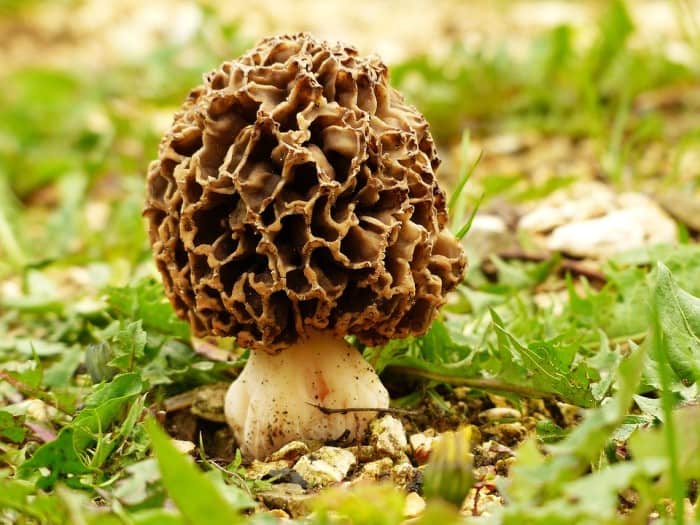
A real morel has a hollow stem, and a securely attached cap. Do not rely on just the stem to tell a safe morel from a poisonous one, because slugs often dine upon the inside of a false morel stem which can make it appear hollow.
❌ 3. Poison Hemlock (conium maculatum)
The only living creature that can survive consuming even a small amount of hemlock is a goat… maybe. This deadly toxic weed looks incredibly like both Queen Anne’s Lace (wild carrot) and wild yarrow.
Typically, poison hemlock will not be found growing in an open field area in full sun like either of the two other common weeds that are highly prized for their medicinal properties by herbalists, but such cross growing patterns can happen.
Poison hemlock tends to thrive in partial shade in moist soil – like along the banks of a creek or river. After a particularly wet period, especially in the early spring, poison Hemlock is most likely to sprout.
Hemlock contains no fewer than eight powerful toxic alkaloid compounds including gamma-coniceine and coniine.
There is no treatment or antidote, for the consumption of poison hemlock. Hemlock poisoning symptoms typically materialize just 20 minutes after ingesting or inhaling spores.
Death typically occurs within three hours after not just consuming poison hemlock but inhaling spores into your nose or getting them into your eyes.
Poisoning via the eyes occurs from either rubbing them after touching the plant or from spores blowing in the wind. Death after the inhalation of hemlock tends to occur more rapidly than ingestion.
The toxins in hemlock cause the respiratory system to become paralyzed – or fail. It takes only a very small amount of toxic spores from a hemlock plant to kill. Consuming less than a walnut sized amount of hemlock will kill a cow.
Poison Hemlock Symptoms
- Dizziness
- Muscle Paralysis
- Trembling
- Coordination Loss
- Pupil dilation
- Enhances Saliva Production
- Weak Pulse – Slowed heartbeat
- Central Nervous System Paralysis
- Respiratory Distress
- Coma
The toxins in poison hemlock are usually released more easily when the plant is growing in a sunny area than when it is located in its more shady environment in moist but not semi-dry soil.
How To Identify Poison Hemlock
- The first growing year, poison hemlock grows a rosette like flower – this is often referred to as the “vegetable stage.” This deadly weed is a biennial that does not truly flower until the second growth season.
- Poison hemlock plants grow substantially taller than either yarrow or wild carrots, on average. A typical poison hemlock plant ranges from eight to 12 feet tall during the second growing year, and stands at least three feet tall during the final part of the first growing season.
- Every flower on a poison hemlock plant contains multiple seeds and fruit that boast dense ridges.
- As the plant matures, the fruit on the hemlock plant flowers turn a gray to brown color.
- Before a hemlock plant reaches maturity the fruit on the flowers are white – this is when they most closely resemble Queen Anne’s Lace or yarrow. This occurs during the second year of growth.
- The stems on poison hemlock plants are not a solid green like the ones that support yarrow and wild carrot plants. Instead, they have purple blotches all over them – making the stems appear as if they have had paint splattered upon them. The stems of the poison hemlock plant somewhat resemble those of the Joe Pye – hogweed plant.
- The stems on hemlock plants are also substantially thicker than those on either wild carrot or yarrow plants.
- Queen Anne’s Lace plant stems have hair, and feel slightly prickly to the touch. Poison hemlock stems are hairless, and have a glossy look to them.
- The leaves on Hemlock plants boast a feathery type shape.
- When you get near poison hemlock plants you will most likely encounter a musty smell – a scent some have even likened to rodent urine. The urine smell is typically more prominent if the leaves of the plant have been disturbed or become crushed beneath your feet.
- Leaves on this deadly wild plant boast three or four pinnately compounds.
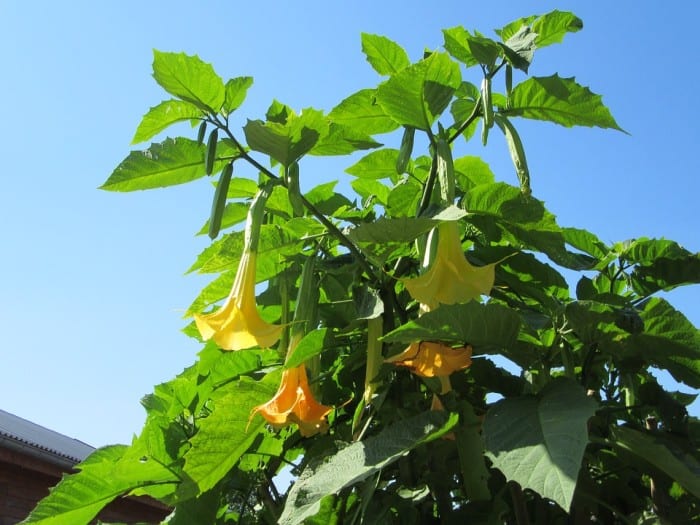
❌ 4. Angel’s Trumpet
This beautiful but deadly plant was aptly nicknamed. Some folks refer to this fragrant flowering plant as “Devil’s Breath”, and again, the name fits. All members of the Solanaceae family are toxic if ingested.
The Brugmansia – the real name of this plant, is one of seven flowering plants in its genus. If consumed, the Angel’s Trumpet plant can cause partial paralysis, diarrhea, and severe migraines.
All parts of the Devil’s Breath plant are extremely poisonous – including the roots and seeds. The toxic alkaloids contained in this plant include hyoscyamine, atropine, and scopolamine.
While compounds from this plant are used in a highly synthesized way in some medications, it is still considered poisonous when used without professional medical supervision.
How to Identify Angel’s Trumpet Plants
- These plants have pendulous flowers that grow with no spines on their fruit.
- Flowers on an Angel’s Trumpet plant come in shades of faded orange, cream, pink, yellow, and white.
- Brugmansia plant leaves are oval.
- The leaves grow close to 10 inches long and close to six inches wide. When the plant is growing in the shade, the leaves are often both longer and more broad.
- The corolla on the trumpet shaped flowers is recurved just slightly.
- The trumpet flowers hang straight down as they grow.
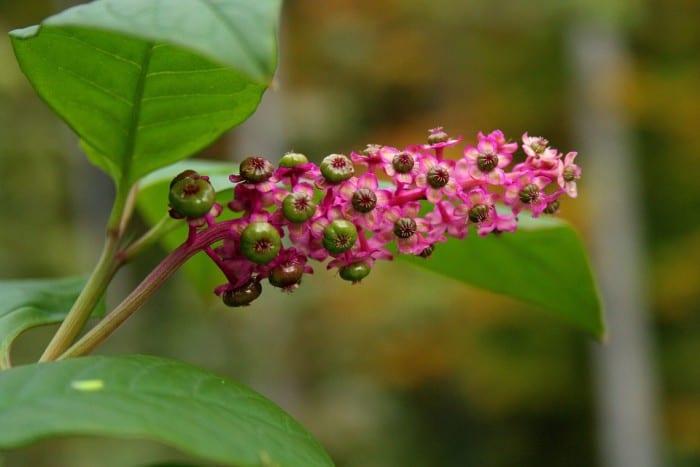
❌ 5. Pokeweed (phytolacca americana)
While pokeweed is a commonly used foraged item in Southern soil food dishes, this common wild plant absolutely cannot safely be eaten raw. Every part of the pokeweed plant is poisonous – especially the roots.
You should not even touch pokeweed plants with bare hands because the toxic compounds can be absorbed into the skin.
Symptoms of pokeweed poisoning include respiratory paralysis, vomiting, and convulsions.
How to Identify Pokeweed Plants
- This plant grows into a large bush – it is classified as a herbaceous perennial.
- This toxic plant reaches 10 feet tall, on average, when it matures.
- Pokeweed grows bushy and tall enough to sometimes be mistaken for a small tree.
- Pokeweed plants boast a massive taproot.
- Stems on this plant are purple to red in shade.
- The stems are smooth, like on a succulent.
- Pokeweed leaves are lance shaped.
- Leaves range in size from five to 20 inches long.
- The fruit produced by the pokeweed plant appears to resemble small grapes and grow in clusters.
- The small dark purple berries appear in the early weeks of fall.
❌ 6. Poison Parsley
This plant not only closely resembles poison hemlock, but also the same safe wild edibles it can be mistaken for if not exercising diligence when foraging. This toxic wild herb looks similar to wild carrot plants after they have gone to seed.
All parts of the poison parsley plant are toxic. This plant is a herbaceous biennial to perennial. The same horrific poisoning symptoms and ultimate result of consuming poison hemlock also occurs if you eat poison parsley.
How to Identify Poison Parsley Plants
- The stems on a poison parsley plant are smooth and erect. They are also hollow in nature, and feature the same purple splotches or speckling as poison hemlock.
- The leaves are glossy, and have a lacy texture.
- The flowers on the plant also look similar to poison hemlock, and to a lesser degree to an untrained eye, like those on yarrow or wild carrot plants.
- The umbrella shaped umbels on the poison parsley support small white flowers as they mature.
- The fruit have a capsule shape, and area shade of gray to green.
- Poison hemlock plants bloom from July through September.
❌ 7. False Garlic – Crow Poison (nothoscordum bivalve)
Crow poison or Nothoscordum bivalve, is a poisonous wild plant from the Amaryllidaceae family.
It grows primarily in southwester and southern states from Virginia to Arizona. False garlic looks a lot like both wild garlic, and wild onion.
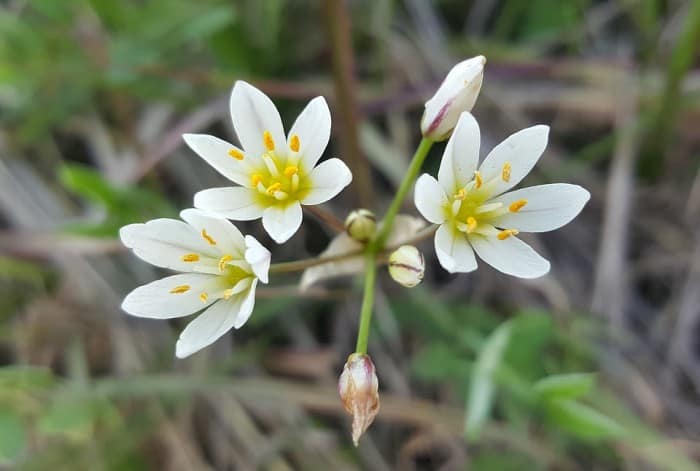
This plant will not typically kill you if consumed it, but can make you severely ill.
Symptoms of false garlic poisoning include: hypotension, nausea, dizziness, vomiting, paresthesia, headache, bradycardia, visual disturbances, and atrioventricular block.
How to Identify False Garlic Plants
- Use your sense of smell to help immediately identify whether or not you are about to forage false garlic or a wild garlic – wild onions. Crow poison does not release a scent even remotely similar to the ones associated with either garlic or onions.
- Flowers on false garlic plants are each on separate stalks, but arise from the exact same location from a single stalk.
- Each flower boasts six petals.
- Crow poison plant stalks are leafless.
- Leaves on this poisonous plant are flat but not hollow, and are basal in shape.
- Leaves are always positioned lower than the flowers.
- Flowers in false garlic plants are either white or a yellowish to greenish hue.
- Wild garlic plant rootstocks are a bulb.
- Crow poison plants typically bloom from March to May but can flower from October through November.
- Wild garlic plants are approximately 10 inches tall when mature.
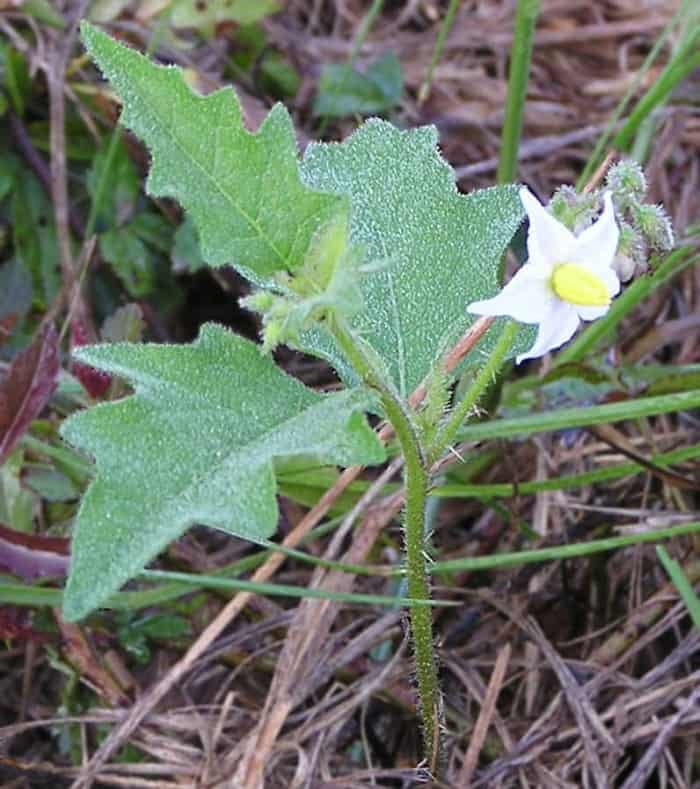
❌ 8. Horse Nettle (solanum carolinense)
This poisonous look-a like plant is a member of the nightshade family. Horse Nettles grow what can be mistaken for mild cherry or grape tomatoes. The plant contains both glycoalkaloid and solanine.
These compounds cause irritation to the gastric and oral mucosa, causing problems with the autonomic nervous system. This bodily system controls multiple internal organs.
All parts of the perennial herbaceous horse nettles plant are toxic. When eaten in large amounts common poisoning symptoms include: dilated pupils, fatigue, reduced respiratory function, and depression.
How to Identify Horse Nettles
- When mature, horse nettle plants grow to approximately 24 inches tall.
- It is an erect plant that also has a distinct branching structure.
- Horse nettle plant leaves are typically 4 to 6 inches long.
- The leaves grow on the stem in an alternate pattern.
- Leaves have lobed margins and boast an irregular but wavy pattern.
- Horse nettle flowers are about three quarters to one inch across, and three to five inches long.
- The flowers on the toxic plant can be in shades of blue, white, or purple.
- Flowering at the top of the plant stems occurs from June through August.
- The fruit produced by horse nettle plants are green when they are first growing, but turn a yellow to red shade as they mature.
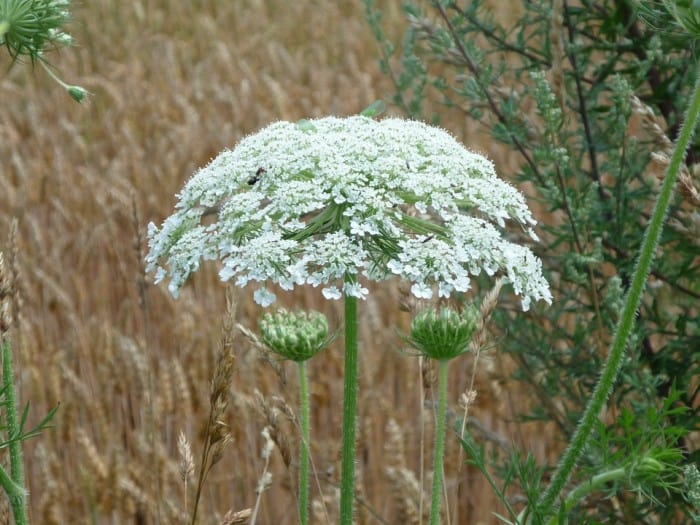
❌ 9. Giant Hogweed (heracleum mantegazzianum)
Newbie foragers who stumble onto a patch of giant hogweed sometimes feel like they have hit the lottery.
Unfortunately for these folks, (or for a less than diligent forager), they have not found the motherload of a wild carrot patch, but instead a poisonous look-alike.
Giant hogweed is a member of the carrot family, but even touching this wild plant can be harmful. The rash that can occur from touching hogweed sap feels like a combination of poison ivy, and the most intense sunburn you have ever had.
Sustaining second or third degree burns from merely chopping down a giant hogweed plant has happened. The sun sensitivity can remain for sometimes as long as six months, if the rash caused by coming into contact with this toxic plant is severe.
Once the hogweed plant compounds have gotten onto your skin it is far more susceptible to the sun’s rays, and often causes a real sunburn.
This toxic plant contains a compound called furanocoumarins that is more than capable of causing intense skin burns when exposed to ultraviolet light. Even after the rash clears up and the blisters heal, permanent scarring can – and often does, still remain.
Giant hogweed is classified as a noxious weed, and is found in most regions of America but particularly in these following states: Ohio, New York, West Virginia, Indiana, Virginia, Oregon, Maine, Illinois, Vermont, Pennsylvania, Washington, Vermont, Connecticut, North Carolina, Massachusetts, and Michigan.
A single giant hogweed plant typically produces about 20,000 seeds that are distributed a minimum of 30 feet from the plant via wind and rain, allowing even one plant the ability to claim an entire area quickly.
How to Identify Giant Hogweed Plants
- As already noted, poison hemlock and giant hogweed can resemble each other. This poisonous plant looks like a hemlock plant on steroids both in height and width.
- Mature giant hogweed plants stand roughly 14 feet tall, on average. It takes about three to five years for these toxic weeds to grow this tall.
- The white flowers that bloom from a giant hogweed are typically up to two feet across, and are white in color.
- Giant hogweed plant leaves are jagged and have lobes that can grow up to five feet wide.
- Stems are thick, rigid, and are dotted with purple blotches like poison hemlock and parsley.
- Giant hogweed stems also feature fine little white hairs.
❌ 10. Tutsan Berries
These supple pretty berries might tempt you to take a bite, but these blueberry toxic look-a likes should never be tossed into your mouth.
The Hypericum androsaemum plant, also commonly referred to as “Sweet Amber” grows throughout the United States and North America.
Eating these toxic berries can cause your heart rate to increase rapidly, fatigue, weakness, and gastrointestinal problems.
If you consume a sizable amount of these berries (perhaps even a few depending on your health), they can be deadly.
The berries from this wild plant have been used in ONLY topical natural home remedies.
How to Identify Tutsan Berries
- These wild toxic berry plants bloom from the early weeks of summer in June through the end of the season.
- The berry plants produce attractive and dainty looking yellow flowers.
- When the berries are growing they are either a shade of white or green and then darker to a red, until ultimately take on a dark blue cast when mature.
- Sweet Amber berries are larger and slightly less round than blueberries.
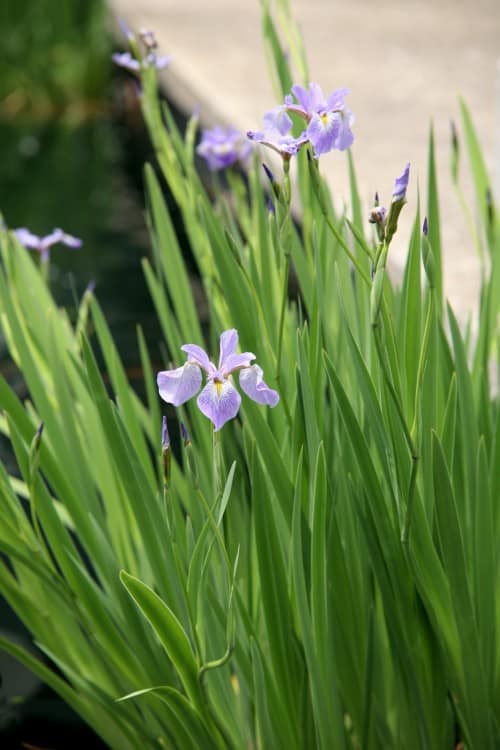
❌ 11. Blue Flag Iris (iris versicolor)
This noxious weed resembles cattail plants. While cattail plants should be among the top of the list for all survivalists to be able to identify and know how to use, the blue flag iris needs to be avoided.
Fortunately, cattails and the blue flag iris closely resemble each other only in the spring before the seed heads develop on the plants.
The juice from this plant can cause dermatitis after touching the skin, and severe stomach ache and diarrhea if eaten.
How to Identify Blue Flag Iris Plants
- This toxic look-a like boasts dainty flowers that range in shade from light blue to dark violet.
- The flowers feature white and yellow stripes – and are highly attractive to honeybees.
- Blue flag iris plants only grow in USDA Agricultural Zones 8 through 10.
- It is a perennial plant that typically grows to stand between 2 to 3 feet tall.
- The sword shaped basal leaves grow in clumps on this cattail look-a like toxic plant.
- Plant leaves are roughly 3 inches long, and can either hang in an erect manner, or become slightly arched if they are exceptionally large.
- Blue flag iris leaves are about one inch wide.
- The leaves on this plant are glabrous and range in shade from a bluish green to a medium shade of green.
- One to two flowers on pedicels that are about one and half inches long grow on the axil of each alternating leaf.
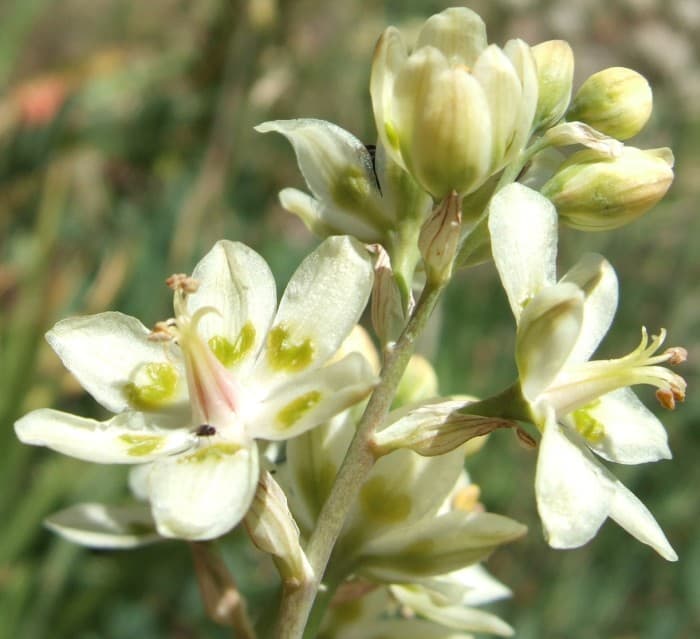
❌ 12. Mountain Death Camas (Anticlea elegans)
Yet another poisonous wild edible look-a like with a fitting name. This plant is of the Anticlea variety and closely resembles wild leeks.
This beautiful plant is in the same family as safe to eat wild garlic and wild onions, but should never be confused as a safe to forage wild plants – the results could be deadly.
Mountain Death Camas (Zigadenus elegans) contain zygadenine, a steroidal alkaloid that could be even more toxic than strychnine.
Consuming as little as half a pound of the plant per 100 pounds of body weight can cause loss of muscle control, an incredible thirst, heart failure, vomiting, intense headaches, coma – and death.
They are often found growing side by side with wild leeks, and look nearly identical to them until they reach the flowering stage.
How to Identify Mountain Death Camas
- The toxic wild plants grow from a bulb that looks incredibly similar to an onion bulb except for its darker outer skin.
- Mountain Death Camas have unbranched and single stems.
- The stem on this poisonous plant grows a cluster of flowers that range in shade from greenish white to cream, and light pink.
- Each cluster of flowers contains small individual flowers with six petals.
❌ 13. Buckthorn (Rhamnus cathartica)
These trees and the fruit that they grow are often mistaken for wild cherries. While the berries are toxic enough to make you sick, the reaction they cause in the body is not typically deadly.
Some folks have intentionally eaten buckthorn berries to use as a natural laxative, but doing so is definitely not advised.
Buckthorn berries and sea buckthorns are entirely different types of fruit. The yellow to orange sea buckthorn berries are entirely safe to eat.
How to Identify Buckthorn
Most buckthorn berries have only one seed in their fruit, unlike the single seed in a cherry – but this differentiating characteristic cannot always be counted upon. Buckthorn berries can have as many as 3 to 4 seeds per berry.
The leaves on both the buckthorn tree and the cherry tree are far too similar (unless you are an absolute expect), to use this part of the tree during an identification review.
But, buckthorn leaves do have three or four veins that curve slightly upward. The middle vein on this tree is indented with the vein running completely from the base to the tip of the leaf.
Buckthorn leaves are slightly more oval and wide in the middle than cherry tree leaves.
The fall is the easiest time of the year to look at the leaves on either a cherry tree or a buckthorn tree and tell the difference. Leaves from the poisonous tree remain green in the fall when all others are turning striking earth tone shades.
Buckthorn berries change in color from purple to a purple so dark they are nearly black. The color change begins in the late days of summer, and continues on through the early fall.
All buckthorn berries remain viable for new growth even five years after they have fallen to the ground. Eradicating buckthorn trees from your land will require the time consuming task of searching within 15 feet of the trees on all sides to collect as many berries as possible.
Buckthorn berries are attached directly to a branch twig instead of being formed into a little cluster that is attached collectively to a twig – as edible berries typically do.
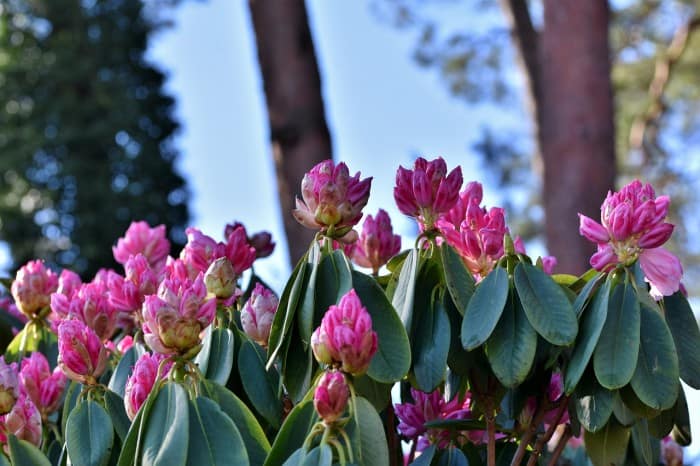
❌ 14. Rhododendrons
Although these plants are commonly grown ornamentally, they can be found in the wild, or discovered in your own back yard.
Once the rhododendrons bush is in bloom, the danger of mistaking the plant for a nutrient-rich herb has passed.
But, before the growing stage reaches this point, rhododendron leaves look nearly identical to bay leaves, which you’d surely want to find in gardens.
All parts of the rhododendron plant are poisonous if consumed – especially the nectar. This sap has traditionally been called “mad honey” because it causes weakness, fatigue, vomiting, and nausea if it gets into your mouth.
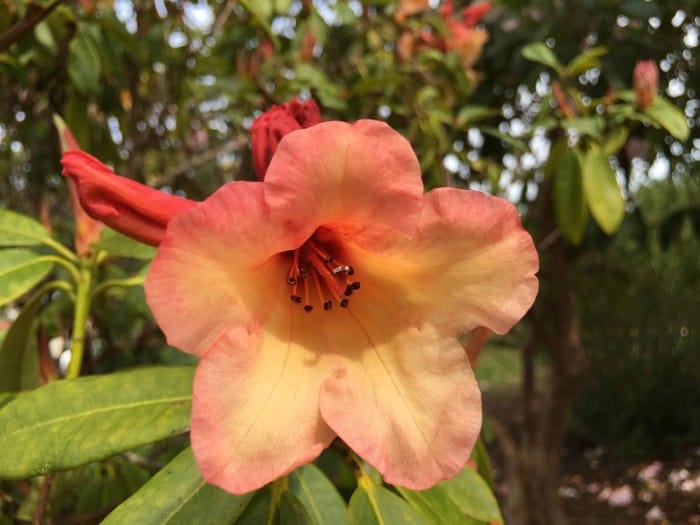
One bite to do a foraging taste test of a leaf will not usually cause much harm, but it will have a nasty bitter taste – alerting you right away it is not a bay leaf.
Spit multiple times to get any remaining particles out of your mouth, rinsing your mouth with water also, if at all possible.
How to Identify a Rhododendron Leaf
- There are multiple varieties of rhododendron, with each having leaves of slightly different shapes. Leaves can range in size from two and a half inches long to close to five inches long. Most leaves from this toxic plant are elliptical in shape and are heavily textured.
- The best way to ensure you do not mistake a rhododendron leaf for a bay leaf is to learn how to identify the herb plant completely – focusing not just on the leaves but the stem, as well.
- While both bay leaves and rhododendron leaves are a dark green color, bay leaves have a shiny look and a smooth texture.

❌ 15. Virginia Creeper (parthenocissus quinquefolia)
Virginia creeper and especially the berries it produces, are toxic if ingested. All parts of this wild plant contain oxalic acids and raphides which can cause a skin irritation in some people who come into topical contact with it.
The highly toxic Virginia creep berry looks juicy and enticing, but eating it can kill you.
Common symptoms associated with consumption of these wild berries include weakened pulse, nausea, diarrhea, abdominal pain, bloody vomiting, dilated pupils, twitching face muscles, drowsiness, and intense sweating.
This deciduous vine can climb as high as 40 feet when it matures. It is when the vine is younger and not climbing to such heights that it is most often likely to be confused with a wild berry bush.
How to Identify Virgina Creeper
- Leaves on this toxic plant contain five leaflets routinely, but can sometimes have three to seven leaflets. Personally, the leaves on Virginia creeper remind me of poison sumac leaves – but I am not sure everyone shares this opinion.
- The leaves have a pointed tip, and a tapered base.
- Virginia creeper leaves are coarsely toothed, and grow up to 6 inches long, on average.
- The tendrils have disks that attach onto either rock or bark as the creeper climbs.
- As fall approaches, Virginia creeper leaves blend in with other beautiful foliage of autumn. The leaves turn vibrant shades of red, purple, or mauve.
- Flowers on this poisonous plant grow in clusters during the early spring and have a light greenish hue.
- Virginia creeper berries are a blue shade, and measure approximately one fourth of an inch in diameter.
Final Words
While there are a copious amount of toxic plants you should never eat – or sometimes even touch, this article lists some of the most deadly.
Learning what wild edibles and toxic plants grow in your region (especially deadly look-alikes) should be an essential part of your survival food security plan.
Keep a wild edibles guide so that you or those loved who must carry on without, are as equipped as possible to avoid making a tragic mistake when foraging.
When in doubt, no matter how hungry you are, pass by a plant you cannot 100% identify.
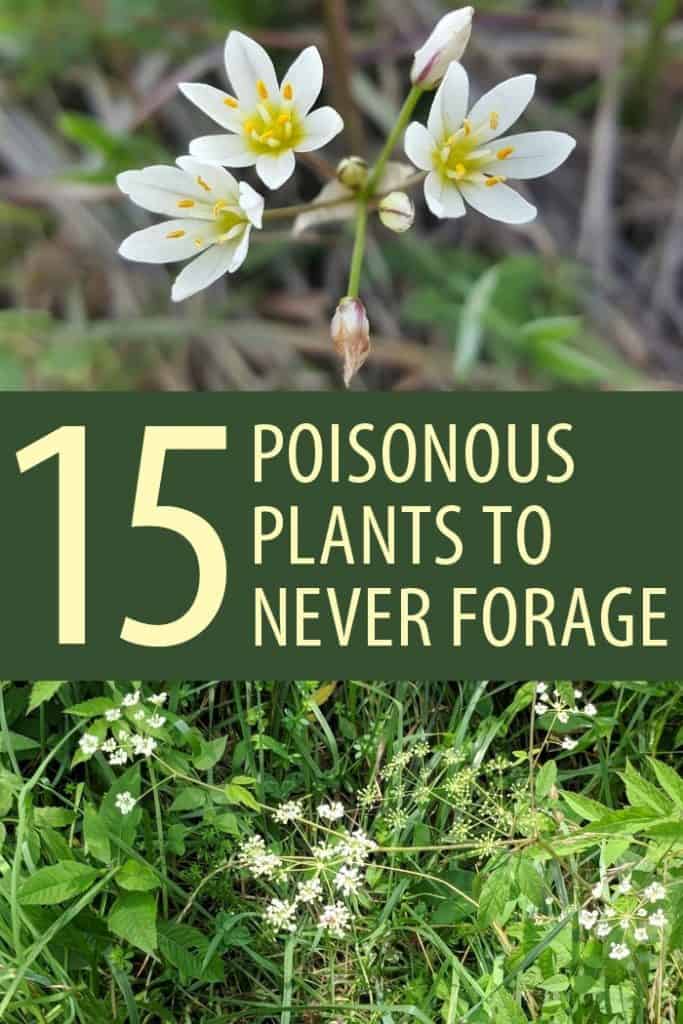

Tara Dodrill is a homesteading and survival journalist and author. She lives on a small ranch with her family in Appalachia. She has been both a host and frequent guest on preparedness radio shows. In addition to the publication of her first book, ‘Power Grid Down: How to Prepare, Survive, and Thrive after the Lights go Out’, Dodrill also travels to offer prepping tips and hands-on training and survival camps and expos.
